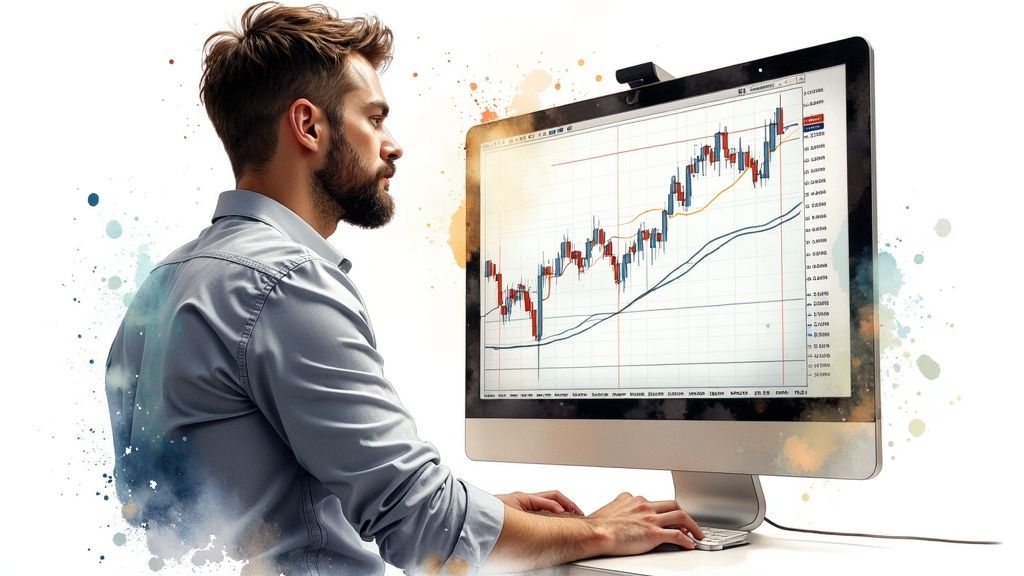



Backtesting lets traders test their strategies using historical market data to assess how they would have performed in the past. This vital step in developing a robust trading approach helps identify problems and improve profitability before real money is at risk. Just as sports teams analyze game footage to enhance performance, backtesting provides critical insights to minimize losses and improve results.
Backtesting goes beyond simple performance analysis - it reveals how strategies interact with different market conditions. A strategy that excels during market uptrends may collapse when trends reverse. Through backtesting, traders can spot these weaknesses and adjust accordingly. The process also helps determine optimal entry/exit points and assess risk factors, leading to more systematic trading decisions based on data rather than emotion.
When backtesting a strategy, traders simulate trades using historical data to measure past performance and risk metrics. For example, testing a strategy on 10 years of market history shows key indicators like total returns, maximum drawdown, win rate, and risk-reward ratios. A moving average crossover strategy tested on the SPY ETF from 2008-2022 would generate metrics like cumulative profit, equity curves, and performance statistics - essential data for evaluating strategy viability. Learn more at Build Alpha.
Several critical elements determine backtesting success. First, accurate historical data forms the foundation - it must be complete and relevant to your target markets. Second, choosing appropriate performance metrics provides a full view of strategy behavior, including profitability, risk exposure, and consistency. Finally, reliable backtesting software with the right features enables proper simulation and analysis. These components work together to generate meaningful insights.
The real value of backtesting comes from applying the results to improve trading strategies. By analyzing backtest data, traders can identify weaknesses, optimize parameters, and make smarter trading decisions. This cycle of testing, analyzing and refining helps develop profitable strategies grounded in historical evidence rather than guesswork. Successful traders consistently use this process to turn market data into practical trading advantages.

When backtesting a trading strategy, looking at just profits and losses only tells part of the story. Getting a clear picture requires analyzing key performance indicators that show how your strategy actually works under real market conditions.
While making money is the end goal, focusing only on total profits during backtesting can hide important risks. For instance, a strategy showing excellent returns might experience wild swings that make it impractical for most traders. This is why examining multiple metrics is essential - they reveal potential problems that basic profit calculations miss.
A thorough backtest should examine these core metrics together to understand strategy performance:
More sophisticated metrics can provide additional insight into strategy behavior:
Using varied performance metrics helps assess strategy effectiveness. Basic measures like net returns and drawdowns provide initial screening. Advanced metrics like Sharpe ratio add risk-adjusted analysis. Maximum drawdown reveals potential loss exposure. Together, these numbers give a complete view for strategy refinement. Learn more about key metrics at TrendSpider's Learning Center.
This analysis helps traders understand real strategy behavior across different market environments. With this knowledge, they can make informed adjustments before committing real capital.
Just as a chef requires pristine ingredients to create an exceptional dish, traders need accurate and relevant data to conduct meaningful backtests. The right data selection approach can mean the difference between reliable insights and misleading results.
Before starting a backtest, identify exactly what data your strategy demands. Simple strategies like moving average crossovers only need historical price data. More sophisticated approaches may require additional datapoints such as trading volume, order flow metrics, or market sentiment indicators. Taking inventory of these needs upfront ensures you gather all essential information.
After determining your data needs, evaluate potential providers. The market offers both free and premium data services. Consider these key factors when selecting a source:
Take time to verify the provider's reputation and understand their data collection methods. This due diligence helps avoid issues later.
Even reputable providers can have data errors. Implement these essential validation checks:
For instance, an unexplained price spike could signal bad data that needs investigation. Thorough validation prevents distorted backtest results.
Markets undergo distinct phases over time. A strategy that excels in bull markets may struggle during bearish periods. Test your approach across multiple market cycles to gauge its adaptability. Include periods of high volatility and market stress in your dataset. This gives you a clearer picture of how your strategy performs under various conditions. The broader your testing environment, the more confidence you can have in your results.

Effective backtesting requires methodical attention to detail and awareness of common pitfalls. This section examines key mistakes that can distort backtest results and provides practical guidance on avoiding them.
Survivorship bias skews results by only including currently active assets while excluding delisted or failed ones. For example, analyzing only stocks still trading today misses the impact of bankruptcies and delistings, making historical returns appear better than reality. To get accurate results, use complete datasets that include delisted securities and factor in failed assets when evaluating strategy performance.
Curve fitting happens when traders fine-tune parameters to match historical data perfectly. Like memorizing exact test answers without understanding the concepts, this approach tends to fail with new market conditions. The solution is out-of-sample testing - validating the strategy on fresh data it hasn't seen before. Keep strategies simple with fewer parameters to reduce overfitting risk.
Look-ahead bias occurs when backtests use data that wouldn't have been available at the actual trade execution time. Using end-of-day prices for intraday trades is a common example - those prices aren't known until markets close. Be strict about only using data that would have been accessible at each decision point to maintain backtest integrity.
Transaction costs like commissions and slippage can seriously impact profitability over time. Include realistic estimates of these expenses in your backtests to understand true net returns. This helps identify strategies that may become unprofitable once real-world costs are factored in. You might be interested in: How to master risk management.
Markets are dynamic and conditions shift regularly. A strategy needs to work across different environments to be truly viable. Robustness testing evaluates performance during various market phases - including volatility spikes, downturns, and unexpected events. Use Monte Carlo simulations to test thousands of possible scenarios and understand how your strategy might handle different conditions.

Backtesting provides essential validation, but moving to live trading presents distinct challenges. The real test begins when putting actual capital at risk in the markets. This section examines how to effectively bridge the gap between simulated success and live market performance while maintaining discipline and risk management.
A structured approach helps ensure consistent execution when transitioning to live markets. Start by establishing clear protocols for every aspect of your trading.
These defined rules serve as guardrails during live trading and help maintain alignment with your tested strategy. Following preset guidelines reduces emotional decision-making under pressure.
Live markets often behave differently than historical data. Being prepared for various scenarios helps navigate evolving conditions.
The ability to adapt while maintaining your core approach is essential for long-term success. Small calibrations help optimize performance without abandoning proven methods.
Ongoing assessment and disciplined risk management are critical once trading live capital.
Consistent monitoring combined with strict risk protocols helps maintain strategy integrity during live trading. This structured approach allows for controlled testing of adjustments while protecting capital. Following these guidelines helps bridge the gap between backtesting and successful live trading performance.

Moving beyond basic backtesting methods is essential for developing robust trading strategies and improving results. This section examines key advanced techniques that can help traders evaluate and refine their strategies more effectively.
While standard backtests only show one historical path, markets are unpredictable by nature. Monte Carlo simulations generate thousands of potential price scenarios based on statistical inputs like volatility and returns. This allows traders to evaluate strategy performance across many different market conditions rather than just historical data. For instance, you can determine how frequently your strategy hits target returns or exceeds drawdown limits, providing a more complete risk assessment.
A common backtesting challenge is avoiding strategies that are over-optimized to past data. Walk-forward analysis solves this by splitting historical data into training and testing periods. You optimize strategy parameters on the training data, then evaluate performance on the unseen test data. This mimics real-world trading conditions as new market data arrives. Testing across multiple time periods helps confirm the strategy works consistently rather than just fitting historical patterns.
Going beyond historical data analysis, agent-based modeling creates virtual market environments with multiple simulated traders following different strategies. By modeling how these traders interact, compete and adapt, you can test your strategy in more dynamic conditions. This is particularly valuable for strategies that depend on market sentiment shifts or liquidity changes.
Traders can choose between commercial and open-source platforms:
| Feature | Premium Platforms | Open-Source Solutions |
|---|---|---|
| Data Integration | Built-in market data access | Manual data preparation required |
| Advanced Analytics | Integrated analysis tools | Custom coding needed for complex tests |
| Cost | Monthly/annual fees | Free but requires more development time |
| Support | Professional support | Community forums and documentation |
The best choice depends on your specific needs around coding ability, strategy complexity, budget and required support level.
As strategies evolve over time, ongoing testing is critical. Automating your backtests through code allows rapid re-testing with new data or parameters. This consistent testing process helps identify needed strategy adjustments quickly as market conditions change.
Using these advanced methods transforms backtesting into a more thorough, data-driven approach. They provide deeper performance insights, highlight potential issues early, and lead to more informed trading decisions.
Ready to improve your crypto trading analysis? Coindive offers comprehensive tools to strengthen your trading strategy. Visit today to explore how our platform can enhance your testing and analysis capabilities.